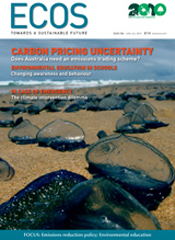
|
Published:
Environmental education in Australian schools
Over the past decade, Australian schools have made considerable progress educating students about the environment and sustainable practices. Cynthia Karena looks at the current state of play.
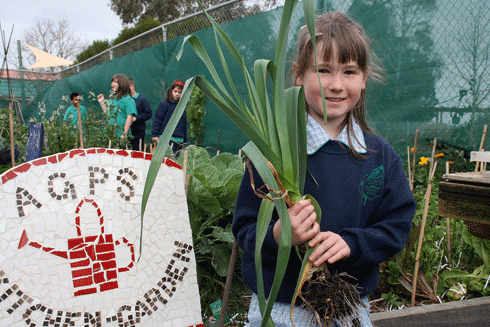
|
|
Harvesting leeks at Altona Green Primary School in Victoria. Credit: Stephanie Alexander Kitchen Garden Foundation
|
Progress in environmental education in Australia has been made through curriculum development, sustainability projects, and the enthusiasm of teachers, parents and the community.
Many community and corporate environmental education programs vie for schools’ attention. They include Landcare, Stephanie Alexander Kitchen Garden Foundation, Gould League Multicultural Gardens, Energy Smart Schools Program, Keep Australia Beautiful, CSIRO’s Carbon Kids, Habitat Heroes, Green Cross, Reef Guardians and Jane Goodall’s Roots and Shoots.
In 2001, in response to the multiplicity of different programs, the Australian Government, in partnership with the States and Territories, developed the Australian Sustainable Schools Initiative (AuSSI). About a quarter of all Australian schools (more than 2000) have participated in AuSSI so far, which was designed to:
-
provide resources, support and ideas for teachers to make schools more sustainable
-
incorporate sustainability into school policy and the curriculum
-
involve parents and the community in sustainability projects.
The 2000 federal government National Action Plan1, which has four key strategies, outlines in part how Australia can participate in the United Nations Decade of Education for Sustainable Development (2005–2014). The first three strategies encourage governments, schools, business and industry to achieve a culture of sustainability by developing policies to reduce their environmental footprint; the fourth strategy is to educate the community and to harness community spirit to live sustainably.
‘[The plan] had very little effect on schools until the 2005 Education Statement2, which gave a framework for what schools could be doing,’ says Professor Annette Gough, who co-authored the statement.
Prof. Gough is a pioneer in Australian environmental education, and now heads the School of Education at RMIT University. She says the 2009 National Action Plan3 ‘puts a stronger agenda for universities in environmental education through teacher education’.
But there is something missing from the plan, says Dr Amy Cutter-Mackenzie, senior education lecturer at Monash University and co-editor of the Australian Journal of Environmental Education.
‘The words nature, wild, consumption, wilderness, animals, place, space or eco do not appear in the document,’ she says. ‘This suggests they have no role in environmental education – or more accurately, education for sustainability’.4
Dr Cutter-Mackenzie cites Sobel5, who argues that environmental education must allow children to ‘have an opportunity to bond with the natural world, to learn to love it and feel comfortable in it, before being asked to heal its wounds’.
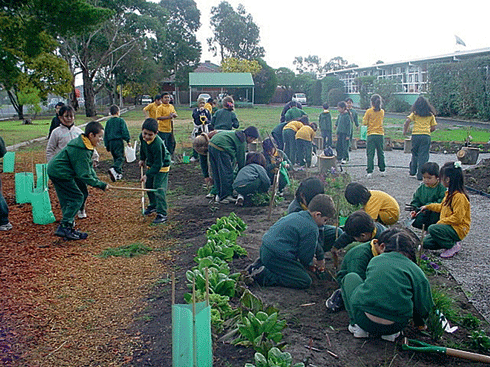
|
| Students at Sunshine North Primary School in Victoria in their multicultural garden. |
‘This is where environmental education starts – with young people: their own lives, their own place, their own environment, and the other-than-human,’ says Dr Cutter-Mackenzie. ‘Such messages are clearly inconsistent with those of ‘education for sustainability’ and/or many popularised conceptions of sustainable development.’
But Cam Mackenzie, an advisor on environmental sustainability to the Queensland government, points out that many countries don’t even have an action plan.
‘We are doing exemplary work in environmental education in Australia; we are leap years ahead,’ says Mackenzie, who has seen environmental initiatives implemented in the United States, United Kingdom, Europe, China, South Africa and India.
‘In general, Australia is better at the curriculum integration, resources minimisation and sustainability action plans than the international programs. Most overseas environmental education programs haven’t the same depth as AuSSI. They tend to follow a more traditional approach that focuses on environmental sustainability issues such as reducing waste, water and energy. We do all that and more. AuSSI also looks at the social, economic and political pillars of environmental education initiatives,’ he says.
|
Habitat Heroes |
Habitat Heroes is a virtual world where kids can connect with other kids around the world, learning about ways to protect the planet and its animals. It is aimed mainly at primary school students. |
The site also has virtual environmental education games and activities to entertain and teach children. |
‘The activities are in line with the AuSSI framework and were developed in consultation with the Victorian Department of Education and Early Childhood Development,’ says Sharon Lowe, the founder of the Habitat Heroes group. |
The Habitat Heroes Climate Quilt project encourages children all over the world to make a personal pledge on patches of recycled fabric, committing to make a small change in their lives that will improve the environment. |
Senator Penny Wong presented a portion of the quilt to the Climate Convention in Copenhagen last year. |
More than 5000 patches have been made by children from Australia, New Zealand, China, the Philippines, Africa, South Africa and America, says Lowe. |
‘Volunteers have helped sew the patches together to make the “Climate Quilt”. It is a true community effort. We are planning on donating the quilt to the United Nations.’ For more information visit: www.HabitatHeroes.com |
Roots and Shoots |
Roots and Shoots is a network and program for youth set up by primatologist Jane Goodall. It provides online resources and ideas to schools across the world. |
‘While the politicians talk about it, let’s start doing something about it,’ says Annette Debenham, Australia’s volunteer Roots and Shoots Manager. |
‘Jane’s real passion is chimps in Tanzania, but she realised she had to get young people involved in the environment to help save the planet. |
‘We are unique because schools [in Roots and Shoots] become part of a global team. A school saving turtles in South Australia can connect with schools in the US to compare notes. A school studying the rainforest can connect with a school in the rainforest,’ says Debenham. For more information visit: www.janegoodall.org.au/Home/Roots--Shoots |
Environmental education and the national curriculum
However, problems arise when government departments develop environmental education programs over education agencies, says Prof. Gough. She says Australia’s global reputation in environmental education has slipped since environmental initiatives stopped being owned by education.
‘The problem is that it is not in the curriculum. There is no requirement for schools to be doing it. Environmental education always relies on enthusiastic [teachers]; there is nothing mandatory,’
she says.
In her paper Recent Trends in Environmental Education in Australia6, Prof. Gough says ‘Sustainability seems to be increasingly incorporated under the umbrella of ‘civics and citizenship’, which overlooks the significant aspects of environmental and ecological understandings that are an integral part of environmental education.’
|
Last Child in the Woods by American author, Richard Louv, introduces the idea of ‘nature deficit disorder’ – a lack of contact with nature leading to a disconnection between children and nature. |
Louv has served as an advisor to the US National Scientific Council on the Developing Child and to the Ford Foundation’s Leadership for a Changing World program. He argues that children need to be reintroduced to the wilderness and claims that a range of psychological conditions, from obesity and depression to attention disorders, can be minimised by children spending more time outside. |
‘Schools in America are very sedentary,’ says Louv. ‘Kids are not getting their hands dirty. They can tell you about the American forest, but not what’s in their own backyard. Kids are very ignorant of the basic things. Nature becomes more of an abstraction rather than real. And then they lose interest. |
‘Teachers are becoming increasingly aware of the issue and are taking students outdoors, but this is discouraged by school boards, where the emphasis is on testing and learning. Recess is cancelled, field trips are cancelled. Teachers are teaching to the test. |
‘This is changing under the Obama administration. The ‘no child left inside’ legislation is in Congress now to give more money to environmental educators and to get kids out of class. |
‘Australia and the UK have been ahead of the game compared to the US,’ he says. |
Louv, R (2005). Last Child in the Woods: Saving our Children from Nature Deficit Disorder. Algonquin Books. |
So, how will environmental education fare under Australia’s impending national curriculum? Dr Sandra Wooltorton, Director of the Centre for Sustainable Regional Futures at Edith Cowan University in Western Australia, is concerned that the proposed changes in the national curriculum will sideline sustainability education.
‘The new curriculum is intended to be back to basics, concentrating on maths, English, science and history,’ says Dr Wooltorton, who is also the Vice President of the Australian Association for Environmental Education (AAEE).
‘Environmental educators are concerned that the national curriculum will separate the basics and make sustainability difficult to integrate. Thematic teaching works beautifully for sustainability education. The new curriculum indicates that sustainability will be a cross-curriculum dimension. While this is a good start, it is our view that the curriculum planners have it the wrong way around.
‘Due to the state of the planet, we need to take education for a sustainable future very seriously. We need to start with ecological literacy and social literacy as key basics, and plan the rest of the curriculum accordingly,’ she says.
Studies of Society and Environment (SOSE) is the main subject in which environment and sustainability are formally taught in the present curriculum.
‘It seems as though the SOSE subject is going in the national shake up, which is an unfortunate loss,’ says Cam Mackenzie. ‘It was developed ten years ago and had the best elements of environmental education, integrating social and environmental sustainability as well as environmental literacy and numeracy. There will be no stand-alone environment subject. This will just leave environment sustainability as an interdisciplinary approach as the only option. This may work, but not having a separate subject lowers the profile of environmental education,’ he says.
|
‘Environmental education for sustainability recognises the essential value of the indigenous world view: that is, a sense of connectedness with one’s environment,’ says Alan Green, the Executive Director of School Education Services in the Northern Territory. |
This connectedness we all have with the environment is what Buddhist schools also focus on in terms of environmental education. |
‘Everything is interconnected,’ says Pamela Cayton, the founder of the Buddhist Essential Education pilot school, Tara Redwood, in California. |
‘Our inner world affects the outer world. We need to improve the positive qualities of our mind, such as compassion for the environment, and eliminate negative states of mind. Both affect how we treat the environment. If we are greedy, we can act selfishly: for example, polluting the environment for personal profit. Minimising the greedy mind minimises the negative action.’ |
Cayton asks students, ‘If you want to live in a nice environment, what can you do to make it happen?’ |
Victoria’s Daylesford Buddhist Primary School has an environmental module based on what children can see outside their window. |
‘I wanted them to be mindful of their environment and to feel a part of it,’ says Tanya Loos, who developed the environment curriculum. She is also the biodiversity project officer for the City of Ballarat. |
Teachers talk to students about actions and their consequences (karma), and how the environment they live in is shaped by the choices they make. |
‘We also teach about mindful consumption. Mindfulness is a central tenet of Buddhist philosophy. Students are mindful of food packaging and where it ends up. They consider how the metal mined for mobile phone parts affects gorillas in Africa,’ says Loos. |
The Catholics have an ecological vision statement – On Holy Ground – which provides schools with a pathway towards more ecologically sustainable practices. Pope John Paul II has promoted ‘Ecological Conversion’ as a goal for all Catholics. |
‘We have to be better stewards of this Earth that God gave us,’ says Gary Burrows, the Catholic Education Office’s Environment Officer for the Sydney southern region. |
Many Catholic schools follow AuSSI and other environmental programs. However, Catholics believe that concern about the environment must be linked to faith, so environmental issues are also being discussed in religious education curriculum programs. |
For more information visit, www.onholyground.edu.au |
What works?
The Australian Research Institute in Education for Sustainability (ARIES) researches how to move beyond raising awareness about the environment to changing people’s behaviour to live sustainably. It looks at education, business, industry, government and the community.
Director of ARIES, Professor Suzanne Benn, says the organisation has a systemic approach.
‘The best way to bring about change is to look at all aspects of a system. In education, we look at all the stakeholders that influence the pace of change. One point of influence is teacher education. We train teachers to incorporate sustainability in education,’ she says.
But changing the way we live takes time, says Dr Wooltorton.
‘We need to bring the community into schools. It is so important to have parents involved. The culture of home and school needs to reflect sustainability imperatives to create social change for a sustainable future. It is vital for students to begin with their own place to achieve basic skills in ecological literacy. It has to be practical and experientially based in their local environment to develop a sense of place, to feel a sense of connection with nature.’
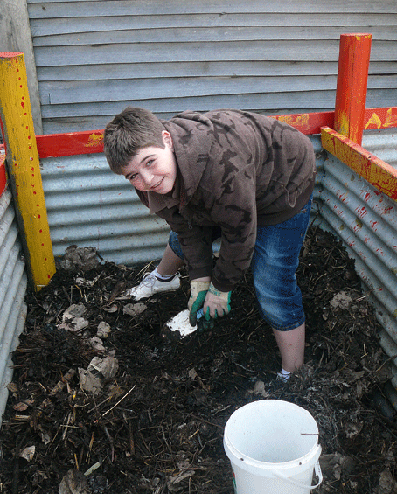
|
|
Maintaining the compost bay at Collingwood College’s garden in Victoria. Credit: Stephanie Alexander Kitchen Garden Foundation.
|
Any successful environmental education program needs resources, an action plan, policies and links to the community, says Mackenzie. The policies are needed because enthusiastic teachers can burn out. ‘Policies live longer than an individual teacher,’ he says.
Schools with access to funded organisations (such as Keep Australia Beautiful, CSIRO Education and shire councils) to support their progress are more likely to succeed, says Alan Green, Executive Director of School Education Services in the Northern Territory.
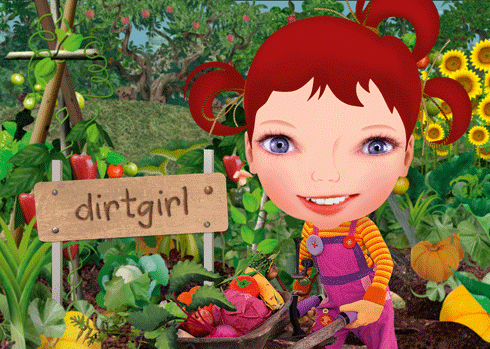
|
|
dirtgirl is the star of ABC TV’s ‘ecotainment’ series, dirtgirlworld, aimed at preschoolers. Credit: dirtgirlworld productions
|
|
How ecoliterate is a five-year-old? |
Biology student Melissa Slarp’s Masters’ project will study the ecoliteracy of kindergarten students in Sydney’s inner west schools. |
Slarp is investigating whether five-year-old children can understand ecological concepts such as biodiversity and conservation, and if this understanding can be improved by classroom activities. |
A pilot study she conducted last year looked at kindergarten students’ drawings of penguins, and revealed that some young children already have a good grasp of ecological concepts. |
dirtgirlworld – the TV series |
dirtgirl grows tomatoes, builds houses for displaced animals, makes pedal power, has worm farms and drives a big orange tractor. |
Her world is all about having fun while living sustainably. She is the star of a TV ‘ecotainment’ series aimed at preschoolers called dirtgirlworld, which mixes live action, animation and photo-montage. The show is screened in Australia, the United Kingdom, Canada, the United States and Israel, and soon in France and Korea. |
Co-creator, Cate McQuillan, says it’s a happy story meant to inspire kids. |
‘We wanted to focus on the small things we can do for more sustainable living. We aren’t dictatorial, we’re not saying if you don’t change your behaviour we’ll all go down the gurgler. We want to show kids the joy of living sustainably.’ |
Kids can also go online to share ideas, use an avatar to express their opinions, and as McQuillan puts it, ‘voice their hopes for the planet’ For more information visit: www.dirtgirlworld.com. |
More information:
Australian Association for Environmental Education (AAEE): www.aaee.org.au
UN Education for Sustainable Development: www.unesco.org/en/esd
SCOPE – science television for kids: www.csiro.au/scope
1 Department of Environment, Water, Heritage and the Arts (2000). Environmental Education for a Sustainable Future (see www.environment.gov.au/education/publications/nap).
2 Department of Environment, Water, Heritage and the Arts (2005). Environmental Education Statement for Australian Schools – Educating for a Sustainable Future (see www.environment.gov.au/education/publications/sustainable-future.html).
3 Department of the Environment Water Heritage and the Arts (2009). Living Sustainably: The Australian Government’s National Action Plan for Education for Sustainability (see www.environment.gov.au/education/nap).
4 Cutter-Mackenzie, A (2010, forthcoming). Re-ecologising education in an era of sustainability. In Studying Society and Environment (4th edition). (Eds R Gilbert and B Hoepper) Chapter 18. Cengage, Melbourne.
5 Sobel, D (1996). Beyond Ecophobia: Reclaiming the Heart in Nature Education, p10. Great Barrington, MA: The Orion Society and The Myrin Institute.
6 Gough, A (2009). Recent Trends in Environmental Education in Australia. RMIT University, Melbourne.


